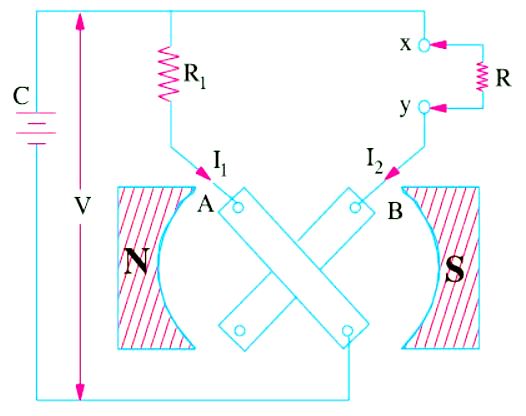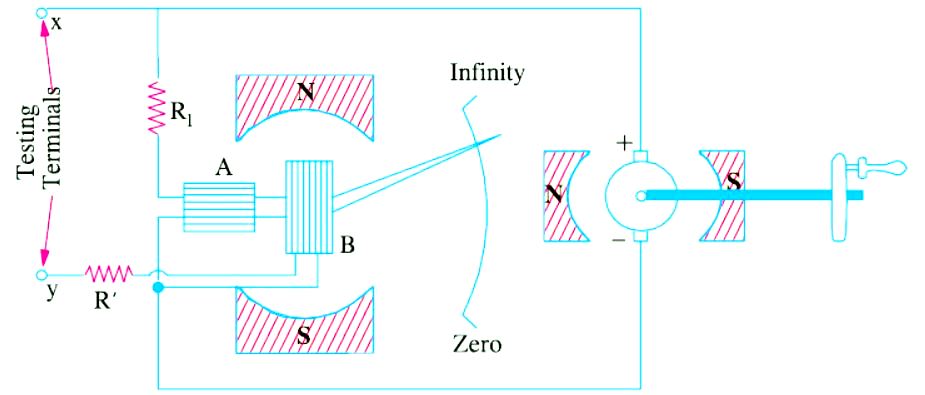Insulation Tester (Megger)
Insulation Tester (Megger) is a portable instrument used for testing the insulation resistance of a circuit and for measuring resistances of the order of megaohms which are connected across the outside terminals XY in Figure (B).

1. Working Principle of insulation Tester (Megger) :
The working principle of a ‘cross-coil’ type megger may be understood from Figure (A) which shows two coils A and B mounted rigidly at right angles to each other on a common axis and free to rotate in a magnetic field. When currents are passed through them, the two coils are acted upon by torques which are in opposite directions. The torque of coil A is proportional to I1 cos θ and that of B is proportional to I2cos (90 − θ) or I2sin θ. The two coils come to a position of equilibrium where the two torques are equal and opposite i.e. where I1cosθ = I2sin θ or tan θ = I1/I2
AdBlock-2
In practice, however, by modifying the shape of pole faces and the angle between the two coils, the ratio I1/I2 is made proportional to θ instead of tan θ in order to achieve a linear scale. Suppose the two coils are connected across a common source of voltage i.e. battery C, as shown in Figure (B). Coil A, which is connected directly across V, is called the voltage (or control) coil. Its current I1 = V/R1. The coil B called current or deflecting coil, carries the current I2 = V/R, where R is the external resistance to be measured. This resistance may vary from infinity (for good insulation or open circuit) to zero (for poor insulation or a short-circuit). The two coils are free to rotate in the field of a permanent magnet. The deflection θ of the instrument is proportional to I1/I2 which is equal to R/R1. If R1 is fixed, then the scale can be calibrated to read R directly (in practice, a current limiting resistance is connected in the circuit of coil B but the presence of this resistance can be allowed for in scaling). The value of V is immaterial so long as it remains constant and is large enough to give suitable currents with the high resistance to be measured.

2. Construction of Insulation Tester :
The essential parts of a megger are shown in Figure (C). Instead of battery C of Figure (B), there is a hand-driven D.C. generator. The crank turns the generator armature through a clutch mechanism which is designed to slip at a pre-determined speed. In this way, the generator speed and voltage are kept constant and at their correct values when testing.
The generator voltage is applied across the voltage coil A through a fixed resistance R1 and across deflecting coil B through a current-limiting resistance R′ and the external resistance is connected across testing terminal XY. The two coils, in fact, constitute a moving-coil voltmeter and an ammeter combined into one instrument.
(i) Suppose the terminals XY are open-circuited. Now, when crank is operated, the generator voltage so produced is applied across coil A and current I1 flows through it but no current flows through coil B. The torque so produced rotates the moving element of the megger until the scale points to ‘infinity’, thus indicating that the resistance of the external circuit is too large for the instrument to measure.
(ii) When the testing terminals XY are closed through a low resistance or are short-circuited, then a large current (limited only by R′) passes through the deflecting coil B. The deflecting torque produced by coil B overcomes the small opposing torque of coil A and rotates the moving element until the needle points to ‘zero’, thus shown that the external resistance is too small for the instrument to measure.

Although, a megger can measure all resistance lying between zero and infinity, essentially it is a high-resistance measuring device. Usually, zero is the first mark and 10 kΩ is the second mark on its scale, so one can appreciate that it is impossible to accurately measure small resistances with the help of a megger.
The instrument described above is simple to operate, portable, very robust and independent of the external supplies.
Read article – Moving-coil Instruments
Visit NCERTplanet.com for NCERT solutions and Textbook downloads




